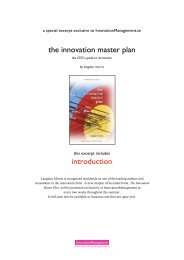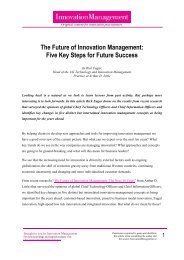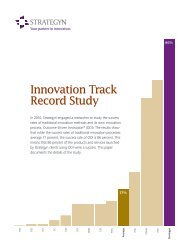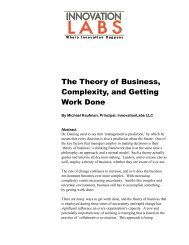Structured Innovation Empowered by TRIZ - Innovation Management
Structured Innovation Empowered by TRIZ - Innovation Management
Structured Innovation Empowered by TRIZ - Innovation Management
Create successful ePaper yourself
Turn your PDF publications into a flip-book with our unique Google optimized e-Paper software.
Pretium Consulting Services (PCS) Value Based <strong>TRIZ</strong> Methods<br />
Systematic Value Advancement (SVA) Process<br />
1. Problem<br />
Definition<br />
2. Ideal<br />
Vision<br />
Figure 2<br />
3. Problem<br />
Formulation<br />
Systematic Value Advancement<br />
4. Idea<br />
Generation<br />
5. Concept<br />
Development<br />
Pretium’s SVA process is based largely on <strong>TRIZ</strong><br />
principles, but it also incorporates best practices<br />
from Six Sigma, Brainstorming, Value Engineering,<br />
Function Analysis System Technique (FAST) and<br />
other well established problem solving techniques.<br />
The SVA process has five steps as shown in Figure<br />
2. Pretium brings three (3) essential resources<br />
together to execute the SVA process: <strong>TRIZ</strong><br />
Master(s) from Pretium, Facilitator(s) from Pretium<br />
and Subject Matter Experts from the client. The<br />
combination of these resources and using a<br />
structured innovation process such as SVA<br />
produces three to ten times the number of out-ofthe-box<br />
ideas than traditional brainstorming methods.<br />
Pretium’s <strong>Structured</strong> <strong>TRIZ</strong> Roadmapping Process<br />
Sub-system 1<br />
Sub-system 2<br />
Sub-system 3<br />
Sub-system 4<br />
Current Paradigm<br />
Roadmapping<br />
Figure 3<br />
I D E A L I T Y<br />
Ideal Vision<br />
Selected<br />
Roadmap<br />
The SVA process is a very useful and<br />
powerful problem solving method.<br />
However, it is based upon existing<br />
systems and the useful and harmful<br />
functions that comprise the system. This<br />
means that SVA is limited to developing<br />
the next generation of product or service.<br />
In order to develop a business or<br />
Intellectual Property (IP) strategy that is far<br />
reaching, we must be able to identify how<br />
a system is likely to evolve. To<br />
accomplish this, Pretium utilizes the<br />
primary <strong>TRIZ</strong> postulate: Technological<br />
systems evolve not randomly, but<br />
according to objective patterns. Based of these evolutionary patterns, Pretium’s Roadmapping<br />
process (Figure 3) facilitates the development of fact-based scenarios which become the basis<br />
for strategy development. Mere extrapolations of the past tend to develop strategies that are<br />
short lived. The evolutionary patterns which form the basis of Roadmapping are abstract<br />
patterns that have been revealed from an exhaustive analysis of the patent fund to identify<br />
evolutionary patterns that are broadly applicable.<br />
“Every organization - not just business - needs one core competence: innovation”<br />
- Peter F. Drucker<br />
“73 percent of companies worldwide will increase spending on innovation in 2005, up from 64<br />
percent in 2004. In addition, more than 90 percent said that generating growth through<br />
innovation has become essential for success in their industry.”<br />
- Boston Consulting Group (BCG)<br />
Copyright 2005 Pretium Consulting Services, LLC












